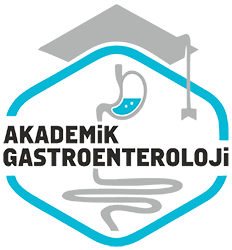Nisan 2023
Kistik fibrozis tanili bir çocuk hastada saptanan özofageal skuamoz hücreli papillom: Nadir ve insidental bir endoskopik bulgu
Esophageal squamous cell papilloma in a child with cystic fibrosis: A rare incidental endoscopic finding
- Ana Sayfa
- Sayılar
- Nisan 2023
- Kistik fibrozis tanili bir çocuk hastada saptanan özofageal skuamoz hücreli papillom: Nadir ve insidental bir endoskopik bulgu...
Özet
Özofageal skuamoz hücreli papillom, özofagusun nadir görülen bir epitel lezyonudur. Çocuklarda özofageal skuamoz hücreli papillom ile ilgili epidemiyolojik veriler kisitlidir ve birkaç vaka raporundan olusmaktadır. Özofageal skuamoz hücreli papillomun etiyolojisi belirsizligini korusa da, özofagus mukozasinin kimyasal/mekanik tahrise bagli gösterdigi hiper-rejeneratif yanit ve human papillomavirus enfeksiyonu en olasi nedenler olarak öne sürülmüstür. Kistik fibrozisli ve kronik dispepsisi olan 14 yaşinda bir kiz çocugunda alt özofagus sfinkterine yakin lokalizasyonda 0.5 x 0.5 cm boyutlarinda, sesil, multilobüle, beyazimsi ve verrüköz polipoid lezyon çikarildi. Histolojik olarak lezyonun benign skuamoz papillom olduğu gösterildi. Hastanın gastroözofageal reflü düsündüren dispeptik semptomları, lezyonun çikarilmasi ve anti-asit tedavi sonrasi düzeldi. Özofageal skuamoz hücreli papillom, üst endoskopide insidental olarak saptanan bir bulgudur. Distal özofageal yerlesimli papillomlardan gastroözofageal reflü hastalığı sorumlu olabilir. Çocuklukta nadir görülmesi nedeniyle, yönetimi ve takibiyle ilgili rehber önerileri yoktur. Malignite potansiyeli konusundaki belirsizlik nedeniyle mümkün olduğunda çikarilmalidirlar
Abstract
Esophageal squamous cell papilloma is an uncommon epithelial lesion of the esophagus. Epidemiological data regarding esophageal squamous cell papilloma in children is scarce and consists of few case reports. Although the etiology of esophageal squamous cell papilloma remains unclear, chemical/mechanical irritation induced hyper-regenerative response of esophageal mucosa and human papillomavirus infection have been suggested as most probable causes. A case of a 14-year-old girl with cystic fibrosis and chronic dyspepsia had a 0.5 x 0.5 cm sessile, multilobulated, whitish and verrucous polypoid mass close to the lower esophageal sphincter removed. Histologically, a benign squamous papilloma was confirmed. Her dyspeptic symptoms suggestive for gastroesophageal reflux resolved after papilloma removal and anti-acid treatment. Esophageal squamous cell papilloma is an incidental finding at upper endoscopy. Gastroesophageal reflux disease may be responsible for distally localized papillomas. Due to its rarity in childhood, there are not any well-established management and surveillance guidelines. Esophageal squamous cell papilloma should be removed, when possible, because of the ambiguity about its malignant potential.



